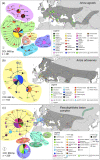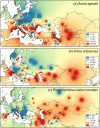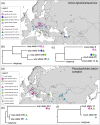Wolbachia affects mitochondrial population structure in two systems of closely related Palaearctic blue butterflies
- PMID: 33542272
- PMCID: PMC7862691
- DOI: 10.1038/s41598-021-82433-8
Wolbachia affects mitochondrial population structure in two systems of closely related Palaearctic blue butterflies
Abstract
The bacterium Wolbachia infects many insect species and spreads by diverse vertical and horizontal means. As co-inherited organisms, these bacteria often cause problems in mitochondrial phylogeny inference. The phylogenetic relationships of many closely related Palaearctic blue butterflies (Lepidoptera: Lycaenidae: Polyommatinae) are ambiguous. We considered the patterns of Wolbachia infection and mitochondrial diversity in two systems: Aricia agestis/Aricia artaxerxes and the Pseudophilotes baton species complex. We sampled butterflies across their distribution ranges and sequenced one butterfly mitochondrial gene and two Wolbachia genes. Both butterfly systems had uninfected and infected populations, and harboured several Wolbachia strains. Wolbachia was highly prevalent in A. artaxerxes and the host's mitochondrial structure was shallow, in contrast to A. agestis. Similar bacterial alleles infected both Aricia species from nearby sites, pointing to a possible horizontal transfer. Mitochondrial history of the P. baton species complex mirrored its Wolbachia infection and not the taxonomical division. Pseudophilotes baton and P. vicrama formed a hybrid zone in Europe. Wolbachia could obscure mitochondrial history, but knowledge on the infection helps us to understand the observed patterns. Testing for Wolbachia should be routine in mitochondrial DNA studies.
Conflict of interest statement
The authors declare no competing interests.
Figures




Similar articles
-
The joint evolutionary histories of Wolbachia and mitochondria in Hypolimnas bolina.BMC Evol Biol. 2009 Mar 24;9:64. doi: 10.1186/1471-2148-9-64. BMC Evol Biol. 2009. PMID: 19317891 Free PMC article.
-
A continental-scale survey of Wolbachia infections in blue butterflies reveals evidence of interspecific transfer and invasion dynamics.G3 (Bethesda). 2022 Sep 30;12(10):jkac213. doi: 10.1093/g3journal/jkac213. G3 (Bethesda). 2022. PMID: 35976120 Free PMC article.
-
Population genetic structure and Wolbachia infection in an endangered butterfly, Zizina emelina (Lepidoptera, Lycaenidae), in Japan.Bull Entomol Res. 2015 Apr;105(2):152-65. doi: 10.1017/S0007485314000819. Epub 2014 Dec 12. Bull Entomol Res. 2015. PMID: 25499047
-
Biogeography and systematics of Aricia butterflies (Lepidoptera, Lycaenidae).Mol Phylogenet Evol. 2013 Jan;66(1):369-79. doi: 10.1016/j.ympev.2012.10.010. Epub 2012 Oct 23. Mol Phylogenet Evol. 2013. PMID: 23099146
-
Wolbachia infections mimic cryptic speciation in two parasitic butterfly species, Phengaris teleius and P. nausithous (Lepidoptera: Lycaenidae).PLoS One. 2013 Nov 6;8(11):e78107. doi: 10.1371/journal.pone.0078107. eCollection 2013. PLoS One. 2013. PMID: 24223136 Free PMC article.
Cited by
-
Conservation Genetics of the Endangered Danube Clouded Yellow Butterfly Colias myrmidone (Esper, 1780) in the Last Central European Stronghold: Diversity, Wolbachia Infection and Balkan Connections.Insects. 2025 Feb 17;16(2):220. doi: 10.3390/insects16020220. Insects. 2025. PMID: 40003849 Free PMC article.
-
The Complete Mitochondrial Genomes of Four Species in the Subfamily Limenitidinae (Lepidoptera, Nymphalidae) and a Phylogenetic Analysis.Insects. 2021 Dec 22;13(1):16. doi: 10.3390/insects13010016. Insects. 2021. PMID: 35055858 Free PMC article.
-
Mitochondrial genomes of four slug moths (Lepidoptera, Limacodidae): Genome description and phylogenetic implications.Ecol Evol. 2024 Apr 29;14(5):e11319. doi: 10.1002/ece3.11319. eCollection 2024 May. Ecol Evol. 2024. PMID: 38694746 Free PMC article.
-
Whole genomes from the extinct Xerces Blue butterfly can help identify declining insect species.Elife. 2024 Oct 4;12:RP87928. doi: 10.7554/eLife.87928. Elife. 2024. PMID: 39365295 Free PMC article.
-
The Incidence of Wolbachia Bacterial Endosymbiont in Bisexual and Parthenogenetic Populations of the Psyllid Genus Cacopsylla (Hemiptera, Psylloidea).Insects. 2021 Sep 22;12(10):853. doi: 10.3390/insects12100853. Insects. 2021. PMID: 34680622 Free PMC article.
References
Publication types
MeSH terms
Substances
LinkOut - more resources
Full Text Sources
Other Literature Sources
Research Materials

